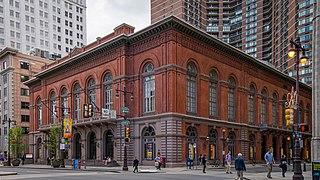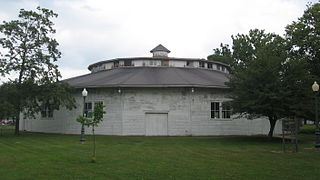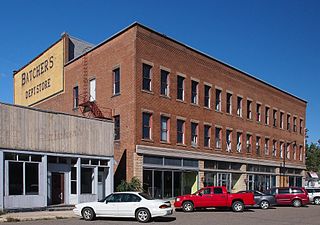
Chautauqua is an adult education and social movement in the United States that peaked in popularity in the late 19th and early 20th centuries. Chautauqua assemblies expanded and spread throughout rural America until the mid-1920s. The Chautauqua brought entertainment and culture for the whole community, with speakers, teachers, musicians, showmen, preachers, and specialists of the day. U.S. President Theodore Roosevelt is often quoted as saying that Chautauqua is "the most American thing in America". What he actually said was: "it is a source of positive strength and refreshment of mind and body to come to meet a typical American gathering like this—a gathering that is typically American in that it is typical of America at its best." Several Chautauqua assemblies continue to gather to this day, including the original Chautauqua Institution in Chautauqua, New York.

The Pan-Pacific Auditorium was a landmark structure in the Fairfax District of Los Angeles, California. It once stood near the site of Gilmore Field, an early Los Angeles baseball venue predating Dodger Stadium. It was located within sight of both CBS Television City on the southeast corner of Beverly and Fairfax Avenue and the Farmers Market on the northeast corner of Third Street and Fairfax. For over 35 years it was the premier location for indoor public events in Los Angeles. The facility was closed in 1972, beginning 17 years of steady neglect and decay. In 1978, the Pan-Pacific Auditorium was included in the National Register of Historic Places, but eleven years later the sprawling wooden structure was destroyed in a fire.

Century Theatres is a movie theater chain that operates many multiplexes in the western United States, primarily in California, Colorado, Nevada, Utah, New Mexico, and Arizona. In its later years, it had expanded into the inter-mountain states, the Pacific Northwest, Texas, Alaska and parts of the Midwestern United States. Founded in 1941, the chain was headquartered in San Rafael, California until it was acquired by Cinemark Theatres from Plano, Texas in 2006. Many now-Cinemark-owned theaters continue to operate under the Century brand.

The Academy of Music, also known as American Academy of Music, is a concert hall and opera house located at 240 S. Broad Street in Philadelphia, Pennsylvania. It is located between Locust and Manning Streets in the Avenue of the Arts area of Center City.

The Central City Opera House is located in the Central City/Black Hawk Historic District in Central City, Colorado, United States. It was constructed in 1878. It has offered operatic and theatrical productions that drew prominent actors and performers in the late 19th-century, and in the early 20th-century it was a motion picture theater.

The Colorado Chautauqua, located in Boulder, Colorado, United States, and started in 1898, is the only Chautauqua west of the Mississippi River still continuing in unbroken operation since the heyday of the Chautauqua Movement in the 1920s. It is one of the few such continuously operating Chautauquas remaining in the United States, and was designated a National Historic Landmark in 2006. According to its governing body, the Colorado Chautauqua Association, it is also unique in that it is the only year-round Chautauqua.

Hazard's Pavilion was a large auditorium in Los Angeles, California, at the intersection of Fifth and Olive Streets. Showman George "Roundhouse" Lehman had planned to construct a large theatre center on the land he purchased at this location, but he went broke and the property was sold to the City Attorney, Henry T. Hazard. The venue was built in 1887 by architects Kysor, Morgan & Walls at a cost of $25,000, a large amount for the time, and seated up to 4,000 people. The building was constructed of wood with a clapboard exterior, and the front was framed by two towers.

The Somerville Theatre is an independent movie theater and concert venue in the Davis Square neighborhood of Somerville, Massachusetts, United States. Over one hundred years old, the Somerville Theatre started off as a vaudeville house and movie theater. The theater has since transitioned and now operates as a live music venue and first-run movie theater. As a music venue, the theater has played host to many historic concerts, including the first of the two Last Dispatch concerts, two shows by Bruce Springsteen in 2003, and a performance by U2 in 2009. Recent live performances have included Ryan Adams & the Cardinals, Cursive, Norah Jones, The Jonas Brothers, Joan Baez, and the John Butler Trio.

An atmospheric theatre is a type of movie palace design which was popular in the late 1920s. Atmospheric theatres were designed and decorated to evoke the feeling of a particular time and place for patrons, through the use of projectors, architectural elements and ornamentation that evoked a sense of being outdoors. This was intended to make the patron a more active participant in the setting.

The Victoria Theatre is a historic 1,154-seat performing arts venue located in downtown Dayton, Ohio. The Victoria hosts a variety of events including theatre, music, dance, film, and comedy.

The 1891 Fredonia Opera House is located in the Village Hall, in downtown Fredonia, New York at 9-11 Church St. Currently a year-round performing arts center, it offers a variety of live performances, presents a cinema series of first run Independent and foreign films, and serves as a rental venue for community meetings, debates, weddings and performances.

The Chautauqua Auditorium, built in 1903, is a large historic icosagonal (20-sided) wooden chautauqua meeting hall located at Forest Park and North East 9th Street, Shelbyville, Illinois, United States. On January 30, 1978, it was added to the National Register of Historic Places.
Swank Motion Pictures, Inc. is an international, non-theatrical, film distributor and licensor. Founded in 1937, it is privately owned and operated by the Swank family. It is one of the world's largest non-theatrical distributors of motion pictures for public performance. Based in Sunset Hills, a suburb of St. Louis, Swank also maintains a sales office in Paris.

Since 1895, Fountain Park has hosted an annual Chatauqua to promote religious, social and educational activities. It was added to the National Register of Historic Places on December 7, 2001.

The Martha Ellen Auditorium, now the State Theatre, was built 1916 in Central City, the county seat of Merrick County in the state of Nebraska in the midwestern United States. It is listed in the National Register of Historic Places, as a well-preserved example of a Nebraska opera house.

The Batcher Opera House Block is a historic 1907 building located in downtown Staples, Minnesota, United States. It contained commercial business on the first floor and an opera house on the 2nd floor. The opera house was an entertainment venue that featured live theater productions from 1907 until the 1920s. It was placed on the National Register of Historic Places in 2004.

The Malco Theatre, located at 817 Central Avenue in Hot Springs, Arkansas, was built on a site that has housed vaudeville shows, silent movies, modern films, and specialty productions. The Malco, which was frequented by Bill Clinton as a boy, has played host to the prestigious Hot Springs Documentary Film Institute (HSDFI). The Art Deco building was added to the National Register of Historic Places on January 21, 2010. The Malco is currently home to the Maxwell Blade Theatre of Magic & Comedy.

The Sheldon Theatre is a historic performance venue in Red Wing, Minnesota, United States, built in 1904. It was listed on the National Register of Historic Places in 1976 as the T.B. Sheldon Memorial Auditorium for having local significance in the theme of performing arts. It was nominated for being the first municipally owned theatre in the United States and a long-standing cultural venue in Red Wing. It later became a contributing property to the Red Wing Mall Historic District as well.

The Cole Memorial Building is a historic municipal event hall in Pequot Lakes, Minnesota, United States. It was built in 1937 with New Deal funding, generating jobs and revenue for a community suffering the effects of the Great Depression. With an auditorium large enough to seat 400 people, the Cole Memorial Building served as a key venue for numerous local events. From 1941 to 1967 it was converted into a municipally-run cinema, the Lakes Theater, whose profits were channeled back into community improvements. The building was listed on the National Register of Historic Places in 2004 as the A.L. Cole Memorial Building for having local significance in the themes of entertainment/recreation, politics/government, and social history. It was nominated for illustrating the long-lived benefits and substantial return on investment achieved with New Deal funding.

Charline McCombs Empire Theatre is a performing arts venue in San Antonio, Texas. It hosts a variety of live events — such as comedy shows, music concerts, children's theater, classic productions — and it is also open for private events. It is listed in the National Register of Historic Places.



















